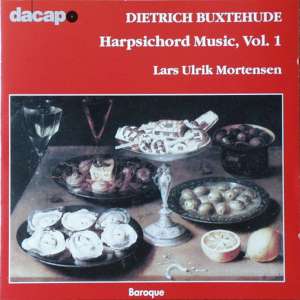|
Larger than life
ANN BOND examines the first of a new Buxtehude series
|

|
I think one would have enjoyed meeting Buxtehude. There is a certain
larger-than-life quality, a bursting-out-of-seams, in the music of this
confident, competent Hanseatic citizen, who gave organ recitals before the
Stock Exchange opened each Thursday, and had extra galleries built in the
Marienkirche to enhance the serial evening concerts he organised. The 39
years he spent in Lubeck quite probably brought him more affectionate fame
than was ever Bach's lot in Leipzig. Though both men bore responsible public
office, they wore it differently; Buxtehude was, if you like, the Liszt
to Bach's Brahms.
 This
genial brilliance is excellently captured in Lars Ulrik Mortensen's recording
of Buxtehude's keyboard music. Starting with a magnificent flourish, improvised
around the chaste semibreve chord in the score, Mortensen plunges into the
G major Toccata with fervour, and we are immediately caught up in a superb
piece of keyboard rhetoric. Mortensen is one of those rare players who really
understands the mainsprings of rubato, and his hastening and easing of the
beat in response to the harmony of the unfolding piece is a joy to listen
to. These toccatas - appropriate to either organ or harpsichord, but sounding
splendid on the latter - were closely imitated by the young Bach, who learnt
from them how to handle the baroque stylus phantasticus : and this
is one of the instances where the pupil did not outshine the teacher. This
genial brilliance is excellently captured in Lars Ulrik Mortensen's recording
of Buxtehude's keyboard music. Starting with a magnificent flourish, improvised
around the chaste semibreve chord in the score, Mortensen plunges into the
G major Toccata with fervour, and we are immediately caught up in a superb
piece of keyboard rhetoric. Mortensen is one of those rare players who really
understands the mainsprings of rubato, and his hastening and easing of the
beat in response to the harmony of the unfolding piece is a joy to listen
to. These toccatas - appropriate to either organ or harpsichord, but sounding
splendid on the latter - were closely imitated by the young Bach, who learnt
from them how to handle the baroque stylus phantasticus : and this
is one of the instances where the pupil did not outshine the teacher.
Buxtehude was a northener through and through, embracing naturally his
Lutheran heritage of chorale suite and variation, but he also brought a
wider perspective to his work. France taught him the orthodox dance idioms,
Italy the renaissance ground basses and the canzona. Italy also furnished
the fuga alla giga, of which Buxtehude made an enthusiastic speciality.
There are no fewer than five specimens of these rollicking fugues, some
ingeniously crafted, on this disc. Humour, too, is never far from the surface:
he can skid impishly into a slippery patch of chromaticism, then right himself
with a nonchalant shake. Yet he can also command a fine, serious northern
vein in the allemands and sarabandes.
Mortensen's ability to penetrate and characterise this music is evident
throughout, and he is ably abetted by the Mandrup-Poulsen copy of a Ruckers
harpsichord which he plays. The closeness of the recording, far from being
a distraction, seems to add to the vivid tonal interest, and the mean-tone
tuning further enriches the impact of the music, adding lustre to apparently
commonplace passages and throwing the occasional chromaticism into dramatic
relief. Not many players would risk ending a disc with a dashing canzona
played only on a four-foot register, but player, builder and tuner emerge
triumphantly from this searching test. An allemande played on the lute register
is equally unusual and effective.
In short, I would recommend this record highly, even though it only contains
52 minutes of music. It wears excellently with repetition, and I look forward
to the sequel.
Copyright © Ann Bond, August 11th
1999
DIETRICH BUXTEHUDE
Harpsichord Music, vol 1
Lars Ulrik Mortensen
Toccata in G major, BuxWV 165
Wie Schön Leuchtet der Morgenstern in G major, BuxWV 223
Suite in D minor, BuxWV 233
Fuga in B flat major, BuxWV 176
Suite in C major, BuxWV 226
Aria in A minor, BuxWV 249
Canzona in C major, BuxWV 166
Partita Auf meinen lieben Gott in E minor, BuxWV 179
Canzonetta in A minor, BuxWV 225
da capo 8.224116 DDD 51'58
ORDER THIS CD FROM CROTCHET |
<< Music & Vision
homepage More CD reviews >>
|